Chain Formation and Phase Separation in Ferrofluids: The Influence on Viscous Properties
Abstract
1. Introduction
2. Main Structures and Approaches
3. Chain-Like Structures and Their Effect on Macroscopic Properties of Ferrofluids
3.1. Magnetoviscous Effect
3.2. Viscoelastic Effects
4. Condensation Phase Transitions in Ferrofluids
4.1. Effect of the Drop Aggregates on the Viscous Properties of Ferrofluids
4.2. Quasi-Elastic and Yield Stress Effects
5. Ferrofluids with Multicore Particles
6. Conclusions
Author Contributions
Funding
Conflicts of Interest
References
- Rosensweig, R. Ferrohydrodynamics; Cambridge University Press: Cambridge, NY, USA, 1985; p. 495. [Google Scholar]
- Blums, E.; Cebers, A.; Majorov, M. Magnetic Fluids; Walter de Gruyter: Berlin, NY, USA, 1997; p. 496. [Google Scholar]
- Berkovsky, B.; Medvedev, V.; Krakov, M. Magnetic Fluids, Engineering Applications; Oxford University Press: Oxford, UK, 1993. [Google Scholar]
- Berkovski, B.; Bashtovoy, V. Magnetic Fluids and Applications Handbook; Begell House: Wallingford, CT, USA, 1996; p. 499. [Google Scholar]
- Charles, S. The preparation of Magnetic Fluids. In Magnetically Controllable Fluids and Their Applications; Odenbach, S., Ed.; Springer: Berlin/Heidelberg, Germany, 2002; pp. 3–18. [Google Scholar]
- Trahms, L. Biomedical Applications of Magnetic Nanoparticles. In Colloidal Magnetic Fluids, Basics, Development and Application of Ferrofluids; Odenbach, S., Ed.; Springer: Berlin/Heidelberg, Germany, 2009; pp. 327–358. [Google Scholar]
- Rosensweig, R. Magnetic fluids. Ann. Rev. Fluid Mech. 1987, 19, 437–463. [Google Scholar] [CrossRef]
- Kamiyama, S.; Okuba, M.; Fujisawa, F. Recent developments of technology in magnetic fluid experiments. Exp. Therm. Fluid Sci. 1992, 5, 641–651. [Google Scholar] [CrossRef]
- Vekas, L. Ferrofluids and Magnetorheological Fluids. Adv. Sci. Technol. 2008, 54, 127–136. [Google Scholar] [CrossRef]
- Genc, S.; Derin, B. Synthesis and rheology of ferrofluids: A review. Curr. Opin. Chem. Eng. 2014, 3, 118–124. [Google Scholar] [CrossRef]
- Joseph, A.; Mathew, S. Ferrofluids: Synthetic Strategies, Stabilization, Physicochemical Features, 510 Characterization, and Applications. ChemPlusChem 2014, 79, 1382–1420. [Google Scholar] [CrossRef]
- Torres-Dıaz, I.; Rinaldi, C. Recent progress in ferrofluids research: Novel applications of magnetically 512 controllable and tunable fluids. Soft Matter 2014, 10, 8584–8602. [Google Scholar] [CrossRef]
- Novopashin, S.A.; Serebryakova, M.A.; Khmel, S.Y. Methods of magnetic fluid synthesis (review). Thermophys. Aeromech. 2015, 22, 397. [Google Scholar] [CrossRef]
- Odenbach, S. Microstructure and rheology of magnetic hybrid materials. Arch. Appl. Mech. 2016, 86, 269–279. [Google Scholar] [CrossRef]
- Afkhami, S.; Renardi, Y. Ferrofluids and magnetically guided superparamagnetic particles in flows: A review of simulations and modeling. J. Eng. Math. 2017, 107, 231–251. [Google Scholar] [CrossRef]
- Puntes, V.F.; Krishnan, K.M.; Alivisatos, A.P. Colloidal nanocrystal shape and size control: The case of cobalt. Science 2001, 291, 2115–2117. [Google Scholar] [CrossRef] [PubMed]
- Klokkenburg, M.; Erne, B.H.; Meeldijk, J.D.; Wiedenmann, A.; Petukhov, A.V.; Dullens, R.P.A.; Philipse, A.P. In Situ imaging of field-induced hexagonal columns in magnetite ferrofluids. Phys. Rev. Lett. 2006, 97. [Google Scholar] [CrossRef]
- Darras, A.; Opsomer, E.; Vandewalle, N.; Lumay, G. Effect of volume fraction on chains of superparamagnetic colloids at equilibrium. Eur. Phys. J. E 2019, 42, 123. [Google Scholar] [CrossRef] [PubMed]
- Weis, J.J.; Levesque, D. Chain formation in low density dipolar hard spheres: A Monte Carlo study. Phys. Rev. Lett. 1993, 71, 2729–2732. [Google Scholar] [CrossRef] [PubMed]
- Levesque, D.; Weis, J.J. Orientational and structural order in strongly interacting dipolar hard sphere. Phys. Rev. E 1994, 49, 5131–5140. [Google Scholar] [CrossRef]
- Kantorovich, S.; Ivanov, A.O. Formation of chain aggregates in magnetic fluids: An influence of polydispersity. J. Magn. Magn. Mater. 2002, 252, 244–246. [Google Scholar] [CrossRef]
- Kantorovich, S.; Cerda, J.; Holm, C. Microstructure analysis of monodisperse ferrofluid monolayers: Theory and simulation. Phys. Chem. Chem. Phys. 2008, 10, 1883–1895. [Google Scholar] [CrossRef]
- Cerda, J.; Kantorovich, S.; Holm, C. Aggregate formation in ferrofluid monolayers: Simulations and theory. J. Phys. Condens. Matter 2008, 20, 204125. [Google Scholar] [CrossRef]
- Trasca, R.A.; Klapp, S.H.L. Structure formation in layered ferrofluid nanofilms. J. Chem. Phys. 2008, 129, 084702. [Google Scholar] [CrossRef]
- Jordanovic, J.; Klapp, S.H.L. Structure of ferrofluid nanofilms in homogeneous magnetic fields. Phys. Rev. E 2009, 79, 021405. [Google Scholar] [CrossRef]
- Minina, E.S.; Muratova, A.B.; Cerdá, J.J.; Kantorovich, S.S. Microstructure of bidisperse ferrofluids in a thin layer. J. Exp. Theor. Phys. 2013, 116, 424–441. [Google Scholar] [CrossRef]
- Weeber, R. Simulation of Novel Magnetic Materials in the Field of Soft Matter. Ph.D. Thesis, University of Stuttgart, Stuttgart, Germany, 2014. [Google Scholar]
- Osaci, M.; Cacciola, M. Study about the nanoparticle agglomeration in a magnetic nanofluid by the Langevin dynamics simulation model using an effective Verlet-type algorithm. Microfluid Nanofluid 2017, 21, 19. [Google Scholar] [CrossRef]
- Liu, Q.; Daqaq, M.F.; Li, G. Magnetization and microstructures of dipolar soft sphere ferrofluid under shear flow: A non-equilibrium molecular dynamics study. J. Appl. Phys. 2018, 124, 195109. [Google Scholar] [CrossRef]
- De Gennes, P.G.; Pincus, P.A. Pair correlations in a ferromagnetic colloid. Phys. Kondens. Mater. 1970, 11, 189–198. [Google Scholar] [CrossRef]
- Jordan, P.C. Association phenomena in a ferromagnetic colloid. Mol. Phys. 1973, 25, 961–973. [Google Scholar] [CrossRef]
- Jordan, P.C. Field dependent chain formation by ferromagnetic colloids. Mol. Phys. 1979, 38, 769–780. [Google Scholar] [CrossRef]
- Osipov, M.A.; Teixeira, P.I.C.; da Gama, M.T. Structure of strongly dipolar fluids at low densities. Phys. Rev. E 1996, 54, 2597–2609. [Google Scholar] [CrossRef]
- Hayes, C.F. Observation of association in a ferromagnetic colloid. J. Colloid Interface Sci. 1975, 52, 239–243. [Google Scholar] [CrossRef]
- Haas, W.E.L.; Adams, J.H. Diffraction effects in ferrofluids. Appl. Phys. Lett. 1975, 27, 571. [Google Scholar] [CrossRef]
- Hayes, C.F.; Hwang, S.R. Observation of magnetically induced polarization in a ferrofluid. J. Colloid Int. Sci. 1977, 52, 239. [Google Scholar] [CrossRef]
- Martinet, A. Biréfringence et dichroisme linéaire des ferrofluides sous champ magnétique. Rheol. Acta 1974, 13, 260. [Google Scholar] [CrossRef]
- Peterson, E.A.; Krueger, D.A. Reversible, field induced agglomeration in magnetic colloids. J. Colloid Interface Sci. 1977, 62, 24–34. [Google Scholar] [CrossRef]
- Bacri, J.-C.; Salin, D. Optical scattering om ferrofluid agglomerate. J. Phys. Lett. 1982, 43, 771–777. [Google Scholar] [CrossRef][Green Version]
- Bacri, J.C.; Salin, D. Instability of ferrofluid magnetic drops under magnetic field. J. Phys. 1982, 43, 649–654. [Google Scholar] [CrossRef]
- Bacri, J.-C.; Salin, D. Bistability of ferrofluid magnetic drops under magnetic field. J. Magn. Magn. Mater. 1983, 39, 48–50. [Google Scholar] [CrossRef]
- Chekanov, V.V.; Drozdova, V.I.; Nutsubidze, P.V.; Skrobotova, T.V.; Cheremushkina, A.V. Aggregation and magnetization change in a magnetic liquid. Magnetohydrodynamics 1984, 20, 1–6. [Google Scholar]
- Pshenichnikov, A.F.; Shurubor, I.Y. Stratification of magnetic fluids: Conditions of formation and magnetic properties of drop-like aggregates. Bull. Acad. Sci. USSR Phys. Ser. 1987, 51, 40–47. [Google Scholar]
- Dikanskii, Y.I.; Polikhronidi, N.G.; Balabanov, K.A. Magnetic susceptibility of a magnetic fluid with 572 microdroplet structure. Magnetohydrodynamics 1988, 24, 211–215. [Google Scholar]
- Khizhenkov, P.K.; Dorman, V.L.; Bar’yakhtar, F.G. The phase diagram of a magnetic fluid 574. Magnetohydrodynamics 1989, 25, 30–35. [Google Scholar]
- Bacri, J.-C.; Perzynski, R.; Cabuil, V.; Massart, R. Phase diagram of an ionic magnetic colloid: Experimental study of the effect of ionic strength. J. Colloid Interface Sci. 1989, 132, 43–53. [Google Scholar] [CrossRef]
- Pshenichnikov, A.F.; Shurubor, I.Y. Effect of temperature on the separation of polydisperse magnetic fluids. Magnetohydrodynamics 1989, 24, 417–420. [Google Scholar]
- Dubois, E.; Cabuil, V.; Boue, F.; Bacri, J.-C.; Perzynski, R.; Massart, R. Phase transitions in magnetic fluids. Prog. Colloid Polym. Sci. 1997, 104, 173–176. [Google Scholar] [CrossRef]
- Islam, M.F.; Lin, K.H.; Lacoste, D.; Lubensky, T.C.; Yodh, A.G. Field-induced structures in miscible ferrofluid 582 suspensions with and without latex spheres. Phys. Rev. E 2003, 67, 021402. [Google Scholar] [CrossRef]
- Gladkikh, D.V.; Dikansky, Y.I. Peculiarities of the interaction of a microdrop-structured magnetic fluid with an alternating magnetic field. Magnetohydrodynamics 2005, 41, 223–230. [Google Scholar]
- Magnet, C.; Kuzhir, P.; Bossis, G.; Meunier, A.; Suloeva, L.; Zubarev, A. Haloing in bimodal magnetic colloids: The role of field-induced phase separation. Phys. Rev. E 2012, 86, 011404. [Google Scholar] [CrossRef]
- Ivanov, A.S. Temperature dependence of the magneto-controllable first-order phase transition in dilute magnetic fluids. J. Magn. Magn. Mater. 2017, 441, 620–627. [Google Scholar] [CrossRef]
- Ezzaier, H.; Alves Marins, J.; Razvin, I.; Abbas, M.; Ben Haj Amara, A.; Zubarev, A.; Kuzhir, P. Two-stage kinetics of field-induced aggregation of medium-sized magnetic nanoparticles. J. Chem. Phys. 2017, 146, 114902. [Google Scholar] [CrossRef] [PubMed]
- Ivanov, A.S. Experimental verification of anomalous surface tension temperature dependence at the interface between coexisting liquid-gas phases in magnetic and Stockmayer fluids. Phys. Fluids 2019, 31, 052001. [Google Scholar] [CrossRef]
- Bashtovoi, V.; Reks, A.; Kuzhir, P.; Zubarev, A.; Volkova, O.; Moroz, V. Effect of magnetophoresis and 595 Brownian diffusion on mechanical processes in magnetic fluids: The role of a condensation phase transition. J. Magn. Magn. Mater. 2020, 498, 166148. [Google Scholar] [CrossRef]
- Zubarev, A.Y.; Ivanov, A.O. Kinetics of a magnetic fluid phase separation induced by an external magnetic field. Phys. Rev. E 1997, 55, 7192–7202. [Google Scholar] [CrossRef]
- Tsebers, A.O. Thermodynamic stability of magnetofluids. Magnetohydrodynamics 1982, 18, 137–142. [Google Scholar]
- Sano, K.; Doi, M. Theory of agglomeration of ferromagnetic particles in magnetic fluids. J. Phys. Soc. Jpn. 1983, 52, 2810–2815. [Google Scholar] [CrossRef]
- Wang, H.; Zhu, Y.; Boyd, C.; Luo, W.; Cebers, A.; Rosensweig, R.E. Periodic branched structures in a phase-separated magnetic colloids. Phys. Rev. Lett. 1994, 72, 1929–1932. [Google Scholar] [CrossRef] [PubMed]
- Buyevich, Y.A.; Zubarev, A.Y. Domain structures in thin layers of ferrocolloids. J. Phys. II Fr. 1993, 3, 1633–1645. [Google Scholar] [CrossRef]
- Shliomis, M.I. Magnetic Fluids. Sov. Phys. Uspekhi 1974, 17, 153–169. [Google Scholar] [CrossRef]
- McTague, J.P. Magnetoviscosity of magnetic colloids. J. Chem. Phys. 1969, 51, 133. [Google Scholar] [CrossRef]
- Shliomis, M.I. Effective Viscosity of Magnetic Suspensions. Sov. Phys. JETP 1972, 34, 1191–1294. [Google Scholar]
- Ambacher, O.; Odenbach, S.; Stierstadt, K. Rotational viscosity in ferrofluids. Z. Phys. B-Condens. Matter 1992, 86, 29–32. [Google Scholar] [CrossRef]
- Shliomis, M.I.; Stepnov, V.I. Rotational viscosity of magnetic fluids: Contribution of the Brownian and Néel relaxational processes. J. Magn. Magn. Mater. 1993, 122, 196–199. [Google Scholar] [CrossRef]
- Ilg, P.; Odenbach, S. Ferrofluid Structure and Rheology. In Colloidal Magnetic Fluids, Basics, Development and Application of Ferrofluids; Odenbach, S., Ed.; Springer: Berlin/Heidelberg, Germany, 2009; pp. 249–325. [Google Scholar]
- Odenbach, S. Magnetoviscous Effects in Ferrofluids; Springer: Berlin/Heidelberg, Germany, 2002. [Google Scholar]
- Zubarev, A.Y.; Fleisher, J.; Odenbach, S. Towards a theory of dynamical properties of polydisperse magnetic 617 fluids: Effect of chain-like aggregates. Physica A 2005, 358, 475–491. [Google Scholar] [CrossRef]
- Melzner, K.; Fleischer, J.; Odenbach, S. New developments in the investigation of magnetoviscous and viscoelastic effects in magnetic fluids. Magnetohydrodynamics 2001, 37, 285–290. [Google Scholar]
- Fleischer, J. Rheologische Eigenschaften Magnetischer Flussigkeiten Unterschiedlicher Chemischer Zusammensetzung. Ph.D. Thesis, Universitaet Bremen, Bremen, Germany, 2004. [Google Scholar]
- Linke, J.M.; Odenbach, S. Anisotropy of the magnetoviscous effect in a cobalt ferrofluid with strong 623 interparticle interaction. J. Magn. Magn. Mater. 2015, 396, 85–90. [Google Scholar] [CrossRef]
- Linke, J. Experimentelle Untersuchungen zur Anisotropie des Magnetoviskosen Effects in Ferrofluiden. Ph.D. Thesis, Technische Universitat Dresden, Dresden, Germany, 2017. [Google Scholar]
- Cebula, D.J.; Charles, S.W.; Popplewell, J. Investigations of aggregation in magnetic liquids using small angle neutron scattering (SANS). J. Magn. Magn. Mater 1983, 31–34, 627–628. [Google Scholar] [CrossRef]
- Rosman, R.; Janssen, J.J.M.; Rekveldt, M.T. Interparticle correlations in Fe3 O4 628 ferrofluids, studied by the small-angle neutron scattering technique. J. Appl. Phys. 1990, 67, 3072–3080. [Google Scholar] [CrossRef]
- Laun, H.; Bung, R.; Hess, S.; Loose, W.; Hess, O.; Hahn, K.; Hädicke, E.; Hingmann, R.; Schmidt, F.; Lindner, P. Rheological and small angle neutron scattering investigation of shear-induced particle structures of concentrated polymer dispersions submitted to plane Poiseuille and Couette flow. J. Rheol. 1992, 36, 743–787. [Google Scholar] [CrossRef]
- Avdeev, M.V.; Balasoiu, M.; Aksenov, V.L.; Garamus, V.M.; Kohlbrecher, J.; Bica, D.; Vekas, L. On the magnetic structure of magnetite/oleic acid/benzene ferrofluids by small-angle 634 neutron scattering. J. Magn. Magn. Mater. 2004, 270, 371–379. [Google Scholar] [CrossRef]
- Pop, L.M.; Odenbach, S.; Wiedenmann, A.; Matoussevitch, N.; Bönnemann, H. Microstructure and rheology 636 of ferrofluids. J. Magn. Magn. Mater. 2005, 289, 303–306. [Google Scholar] [CrossRef]
- Pop, L.M.; Odenbach, S. Investigation of the microscopic reason for the magnetoviscous effect in ferrofluids 638 studied by small angle neutron scattering. J. Phys. Condens. Matter 2006, 18, S2785–S2802. [Google Scholar] [CrossRef][Green Version]
- Linke, J.M.; Odenbach, S. Anisotropy of the magnetoviscous effect in a ferrofluid with weakly interacting 640 magnetite nanoparticles. J. Phys. Condens. Matter 2015, 27, 176001. [Google Scholar] [CrossRef]
- Siebert, E.; Dupuis, V.; Neveu, S.; Odenbach, S. Rheological investigations on the theoretical 642 predicted “poisoning” effect in bidisperse ferrofluids. J. Magn. Magn. Mater. 2015, 374, 44–49. [Google Scholar] [CrossRef]
- Felicia, L.J.; Philip, J. Probing of field-induced structures and tunable rheological properties of surfactant 644 capped magnetically polarizable nanofluids. Langmuir 2013, 29, 110–120. [Google Scholar] [CrossRef]
- Thurm, S.; Odenbach, S. The influence of magnetic separation on the magnetoviscous behavior of ferrofluids. Magnetohydrodynamics 2001, 37, 291–296. [Google Scholar]
- Thurm, S.; Odenbach, S. Particle size distribution as key parameter for the flow behavior of ferrofluids. Phys. Fluids 2003, 15, 1658–1664. [Google Scholar] [CrossRef]
- Rodriguez-Arco, L.; Lopez-Lopez, M.T.; Duran, J.D.G.; Zubarev, A.; Chirikov, D. Stability and magnetorheological behaviour of magnetic fluids based on ionic liquids. J. Phys. Condens. Matter 2011, 23, 455101. [Google Scholar] [CrossRef] [PubMed]
- Borin, D.Y.; Odenbach, S. Magnetic measurements on frozen ferrofluids as a method for estimating the magnetoviscous effect. J. Phys. Condens. Matter 2009, 21, 246002. [Google Scholar] [CrossRef] [PubMed]
- Gerth-Noritzsch, M.; Borin, D.Y.; Odenbach, S. Anisotropy of the magnetoviscous effect in ferrofluids containing nanoparticles exhibiting magnetic dipole interaction. J. Phys. Condens. Matter 2011, 23, 346002. [Google Scholar] [CrossRef]
- Sreekumari, A.; Ilg, P. Anisotropy of magnetoviscous effect in structure-forming ferrofluids. Phys. Rev. E 2015, 92, 012306. [Google Scholar] [CrossRef]
- Zablotsky, D.; Blums, E.; Herrmann, H.J. Self-assembly and rheology of dipolar colloids in simple shear studied using multi-particle collision dynamics. Soft Matter 2017, 13, 6474–6489. [Google Scholar] [CrossRef]
- Zablotsky, D. Field effect in the viscosity of magnetic colloids studied by multi-particle collision dynamics. J. Magn. Magn. Mater. 2019, 474, 462–466. [Google Scholar] [CrossRef]
- Zubarev, A.Y.; Iskakova, L.Y. Effect of chainlike aggregates on dynamical properties of magnetic liquids. Phys. Rev. E. 2000, 61, 5415–5421. [Google Scholar] [CrossRef]
- Sreekumari, A.; Ilg, P. Slow relaxation in structure-forming ferrofluids. Phys. Rev. E 2013, 88, 042315. [Google Scholar] [CrossRef]
- Chirikov, D.N.; Fedotov, S.P.; Iskakova, L.Y.; Zubarev, A.Y. Viscoelastic properties of ferrofluids. Phys. Rev. E 2010, 82, 051405. [Google Scholar] [CrossRef] [PubMed]
- Balan, C.; Broboana, D.; Gheorghiu, E.; Vekas, L. Rheological characterization of complex fluids in 668 electro-magnetic fields. J. Non-Newton. Fluid Mech. 2008, 154, 223-0. [Google Scholar] [CrossRef]
- Borin, D.; Odenbach, S. Relaxation dynamics of the rheological properties of ferrofluids. Proc. Appl. Math. Mech. 2009, 9, 519–520. [Google Scholar] [CrossRef]
- Li, Z.; Li, D.; Chao, D.; Cheng, Y. Study on the creep and recovery behaviors of ferrofluids. Smart Mater. Struct. 2017, 26, 105022. [Google Scholar]
- Buyevich, Y.A.; Ivanov, A.O. Equilibrium properties of ferrocolloids. Physica A 1992, 190, 276–294. [Google Scholar] [CrossRef]
- Morozov, K.I. Thermodynamics of magnetic fluids. Bull. Acad. Sci. USSR Phys. Ser. 1987, 51, 32–39. [Google Scholar]
- Benkoski, J.J.; Deacon, R.M.; Land, H.B.; Baird, L.M.; Breidenich, J.L.; Srinivasan, R.; Clatterbaugh, G.V.; Keng, P.Y.; Pyun, J. Dipolar assembly of ferromagnetic nanoparticles into magnetically driven artificial cilia. Soft Matter 2010, 6, 602–609. [Google Scholar] [CrossRef]
- Satoh, A.; Chantrell, R.W.; Kamiyama, S.I.; Coverdale, G.N. Three dimensional Monte Carlo simulations of thick chainlike clusters composed of ferromagnetic fine particles. J. Colloid Interface Sci. 1996, 181, 422–428. [Google Scholar] [CrossRef]
- Hynninen, A.-P.; Dijkstra, M. Phase diagram of dipolar hard and soft spheres: Manipulation of colloidal 681 crystal structures by an external field. Phys. Rev. Lett. 2005, 94, 138303. [Google Scholar] [CrossRef]
- Hynninen, A.-P.; Dijkstra, M. Phase behavior of dipolar hard and soft spheres. Phys. Rev. E 2005, 72, 051402. [Google Scholar] [CrossRef]
- Bossis, G.; Volkova, O.; Lacis, S.; Meunier, A. Magnetorheology: Fluids, Structures and Rheology. In Ferrofluids, Magnetically Controllable Fluids and Their Applications; Odenbach, S., Ed.; Springer: Berlin/Heidelberg, Germany, 2002; pp. 202–230. [Google Scholar]
- Borin, D. Targeted patterning of magnetic microparticles in a polymer composite. Philos. Trans. R. Soc. A 2020, 378, 20190256. [Google Scholar] [CrossRef] [PubMed]
- Van Roij, R. Theory of chain association versus liquid condensation. Phys. Rev. Lett. 1996, 76, 3348–3351. [Google Scholar] [CrossRef]
- Tavares, J.M.; da Gama, M.T.; Osipov, M.A. Criticality of dipolar fluids: Liquid-vapor condensation 690 versus phase separation in systems of living polymers. Phys. Rev. E 1997, 56, R6252–R6255. [Google Scholar] [CrossRef]
- Van Levin, L.; Kuhn, P.S.; Barbosa, M.C. Criticality in polar fluids. Physica A 2001, 292, 129–136. [Google Scholar] [CrossRef][Green Version]
- Rovigatti, L.; Russo, J.; Sciortino, F. Structural properties of the dipolar hard-sphere fluid at low temperatures and densities. Soft Matter 2012, 8, 6310–6319. [Google Scholar] [CrossRef]
- Rovigatti, L.; Russo, J.; Sciortino, F. No evidence of gas-liquid coexistence in dipolar hard spheres. Phys. Rev. Lett. 2011, 107, 237801. [Google Scholar] [CrossRef]
- Ganzenmuller, G.; Patey, G.N.; Camp, P.J. Vapour-liquid phase transition of dipolar particles. Mol. Phys. 2009, 107, 403–413. [Google Scholar] [CrossRef]
- van Leeuwen, M.E.; Smit, B.; Hendriks, E.M. Vapour-liquid equilibria of stockmayer fluids computer simulations and perturbation theory. Mol. Phys. 1993, 78, 271–283. [Google Scholar] [CrossRef]
- Stevens, M.J.; Grest, G.S. Phase coexistence of a Stockmayer fluid in an applied field. Phys. Rev. E 1995, 51, 5976–5983. [Google Scholar] [CrossRef]
- Kristof, T.; Liszi, J.; Szalai, I. Phase separation in model polydisperse ferrofluids. Phys. Rev. E 2004, 69, 062106. [Google Scholar] [CrossRef]
- Gao, G.T.; Woller, J.B.; Zeng, X.C.; Wang, W. Vapour-liquid equilibria of binary mixtures containing Stockmayer molecules. J. Phys. Condens. Matter 1997, 9, 3349–3360. [Google Scholar] [CrossRef]
- Richardi, J.; Pileni, M.P.; Weis, J.-J. Self-organization of magnetic nanoparticles: A Monte Carlo study. Phys. Rev. E 2008, 77, 061510. [Google Scholar] [CrossRef] [PubMed]
- Zubarev, A.Y.; Iskakova, L.Y. Condensation phase transitions in ferrofluids. Physica A 2004, 335, 325–338. [Google Scholar] [CrossRef]
- Iskakova, L.Y.; Smelchakova, G.A.; Zubarev, A.Y. Condensation phase transitions in ferrofluids. Phys. Rev. E 2009, 79, 011401. [Google Scholar] [CrossRef] [PubMed]
- Wang, Z.; Holm, C.; Müller, H.W. Molecular dynamics study on the equilibrium magnetization properties and structure of ferrofluids. Phys. Rev. E 2002, 66, 021405. [Google Scholar] [CrossRef] [PubMed]
- Pshenichnikov, A.F.; Mekhonoshin, V.V. Cluster structure and the first-order phase transition in dipolar systems. Monte Carlo simulations. Eur. Phys. J. E 2001, 6, 399–407. [Google Scholar] [CrossRef]
- Ivanov, A.O.; Zubarev, A.Y. Ostwald ripening kinetics in a magnetic fluid made metastable by a strengthening of an external magnetic field. Phys. Rev. E 1998, 58, 7517–7522. [Google Scholar] [CrossRef]
- Shul’man, Z.P.; Kordonskii, V.I.; Zal’tsgendler, E.A.; Prokhorov, I.V.; Khusid, B.M.; Demchuk, S.A. Dynamic and physical properties of ferrosuspensions with a structure rearranged by an external magnetic field. Magnetohydrodynamics 1984, 20, 354–361. [Google Scholar]
- Halsey, T.C.; Martin, J.E.; Adolf, D. Rheology of electrorheological fluids. Phys. Rev. Lett. 1992, 68, 1519–1522. [Google Scholar] [CrossRef]
- Lopez-Lopez, M.T.; Kuzhir, P.; Zubarev, A. Effect of drop-like aggregates on the viscous stress in magnetic suspensions. J. Non-Newton. Fluid Mech. 2014, 208–209, 53–58. [Google Scholar] [CrossRef]
- Zubarev, A.; Iskakova, L.; Lopez-Lopez, M.T.; Kuzhir, P.; Bossis, G. On the theory of magnetoviscous effect in magnetorheological suspensions. J. Rheol. 2014, 58, 1673–1692. [Google Scholar] [CrossRef]
- Berli, C.L.A.; De Vicente, J. A structural viscosity model for magnetorheology. Appl. Phys. Lett. 2012, 101, 021903. [Google Scholar] [CrossRef]
- Borin, D.Y.; Bergmann, C.; Odenbach, S. Characterization of a magnetic fluid exposed to a shear flow and 728 external magnetic field using small angle laser scattering. J. Magn. Magn. Mater. 2020, 497, 165959. [Google Scholar] [CrossRef]
- Nowak, J.; Borin, D.; Haefner, S.; Richter, A.; Odenbach, S. Magnetoviscous effect in ferrofluids diluted with sheep blood. J. Magn. Magn. Mater. 2017, 442, 383–390. [Google Scholar] [CrossRef]
- Volkova, O.; Cutillas, S.; Bossis, G. Shear banded flows and nematic-to-isotropic transition in ER and MR fluids. Phys. Rev. Lett. 1999, 82, 233–236. [Google Scholar] [CrossRef]
- Lopez-Lopez, M.T.; Kuzhir, P.; Lacis, S.; Bossis, G.; Gonzalez-Caballero, F.; Duran, J.D.G. Magnetorheology for suspensions of solid particles dispersed in ferrofluids. J. Phys. Condens. Matter 2006, 18, S2803–S2813. [Google Scholar] [CrossRef]
- Lopez-Lopez, M.T.; Kuzhir, P.; Meunier, A.; Bossis, G. Synthesis and magnetorheology of suspensions of cobalt particles with tunable particle size. J. Phys. Condens. Matter 2010, 22, 324106. [Google Scholar] [CrossRef]
- Gomez-Ramirez, A.; Lopez-Lopez, M.T.; Duran, J.D.G.; Gonzalez-Caballero, F. Influence of particle shape on the magnetic and magnetorheological properties of nanoparticle suspension. Soft Matter 2009, 5, 3888–3895. [Google Scholar] [CrossRef]
- Zubarev, A.Y.; Iskakova, L.Y. Yield stress in thin layers of ferrofluids. Physica A 2006, 365, 265–281. [Google Scholar] [CrossRef]
- Shahnazian, H.; Odenbach, S. Yield stress in ferrofluids. Int. J. Mod. Phys. B 2007, 21, 4806–4812. [Google Scholar] [CrossRef]
- Shahnazian, H.; Odenbach, S. Rheological investigations of ferrofluids with a shear stress controlled rheometer. J. Phys. Condens. Matter 2008, 20, 204137. [Google Scholar] [CrossRef] [PubMed]
- Shahnazian, H. Schubspannung-gesteuerte rheologische Untersuchungen an Ferrofluiden. Ph.D. Thesis, Technische Universitat Dresden, Dresden, Germany, 2009. [Google Scholar]
- Borin, D.; Odenbach, S. Rheology of novel ferrofluids. Int. J. Mod. Phys. B 2011, 25, 963–969. [Google Scholar] [CrossRef]
- Muller, R.; Steinmetz, H.; Zeisberger, M.; Schmidt, C.; Dutz, S.; Hergt, R.; Gawalek, W. Precipitated iron oxide particles by cyclic growth. Z. Phys. Chem. 2006, 220, 51–57. [Google Scholar] [CrossRef]
- Dutz, S.; Andra, W.; Hergt, R.; Muller, R.; Oestreich, C.; Schmidt, C.; Topfer, J.; Zeisberger, M.; Bellemann, M.E. Influence of dextran coating on the magnetic behaviour of iron oxide nanoparticles. J. Magn. Magn. Mater. 2007, 311, 51–54. [Google Scholar] [CrossRef]
- Dutz, S.; Clement, J.; Eberbeck, D.; Gelbrich, T.; Hergt, R.; Mueller, R.; Wotschadlo, J.; Zeisberger, M.J. Ferrofluids of magnetic multicore nanoparticles for biomedical applications. J. Magn. Magn. Mater. 2009, 321, 1501–1504. [Google Scholar] [CrossRef]
- Dutz, S.; Kettering, M.; Hilger, I.; Mueller, R.; Zeisberger, M. Magnetic multicore nanoparticles for hyperthermia—Influence of particle immobilization in tumour tissue on magnetic properties. Nanotechnology 2011, 22, 265102. [Google Scholar] [CrossRef]
- Dutz, S.; Kuntsche, J.; Eberbeck, D.; Mueller, R.; Zeisberger, M. Asymmetric flow field-flow fractionation of superferrimagnetic iron oxide multicore nanoparticles. Nanotechnology 2012, 23, 355701. [Google Scholar] [CrossRef]
- Zablotsky, D.; Kralj, S.; Kitenbergs, G.; Maiorov, M. Features of magnetorheology of chain-forming ferrofluids with multi-core magnetic nanoparticles: Experiment and simulation. Colloids Surf. A Physicochem. Eng. Asp. 2020, 603, 125079. [Google Scholar] [CrossRef]
- Zablotsky, D.; Kralj, S.; Kitenbergs, G.; Maiorov, M.M. Relating magnetization, structure and rheology in 761 ferrofluids with multi-core magnetic nanoparticles. J. Non-Newton. Fluid Mech. 2020, 278, 104248. [Google Scholar] [CrossRef]
- Borin, D.; Zubarev, A.; Chirikov, D.; Muller, R.; Odenbach, S. Ferrofluid with clustered iron nanoparticles: Slow relaxation of rheological properties under joint action of shear flow and magnetic field. J. Magn. Magn. Mater. 2011, 323, 1273–1277. [Google Scholar] [CrossRef]
- Borin, D.Y.; Zubarev, A.Y.; Chirikov, D.N.; Odenbach, S. Stress relaxation in a ferrofluid with clustered nanoparticles. J. Phys. Condens. Matter 2014, 26, 406002. [Google Scholar] [CrossRef] [PubMed]
- Nowak, J.; Wiekhorst, F.; Odenbach, S. The influence of hydrodynamic diameter and core composition on the magnetoviscous effect of biocompatible ferrofluids. J. Phys. Condens. Matter 2014, 26, 176004. [Google Scholar] [CrossRef] [PubMed]
- Nowak, J.; Wolf, D.; Odenbach, S. A rheological and microscopical characterization of biocompatible ferrofluids. J. Magn. Magn. Mater. 2014, 354, 98–104. [Google Scholar] [CrossRef]
- Nowak, J.; Dohmen, E.; Odenbach, S. The Magnetoviscous Effect of a Biocompatible Ferrofluid at High Shear Rates. Ieee Trans. Magn. 2014, 50, 4600304. [Google Scholar] [CrossRef]
- Nowak, J.; Odenbach, S. A capillary viscometer designed for the characterization of biocompatible ferrofluids. J. Magn. Magn. Mater. 2016, 411, 49–54. [Google Scholar] [CrossRef]
- Laherisheth, Z.; Parekh, K.; Upadhyay, R. The Effect of Magnetic Field on the Structure Formation in an Oil-Based Magnetic Fluid with Multicore Iron Oxide Nanoparticles. J. Nanofluids 2018, 7, 1–8. [Google Scholar] [CrossRef]
- Ivanov, A.O. Phase separation of ionic ferrofluids. Colloid J. 1997, 59, 446–454. [Google Scholar]
- Ivanov, A.O.; Novak, E.V. Phase separation of ferrocolloids: The role of van der Waals interaction. Colloid J. 2007, 69, 302–311. [Google Scholar] [CrossRef]
- Krutikova, E.; Ivanov, A.O. The role of van der Waals forces in ferrofluid phase separation. Phys. Procedia 2010, 9, 49–53. [Google Scholar] [CrossRef]
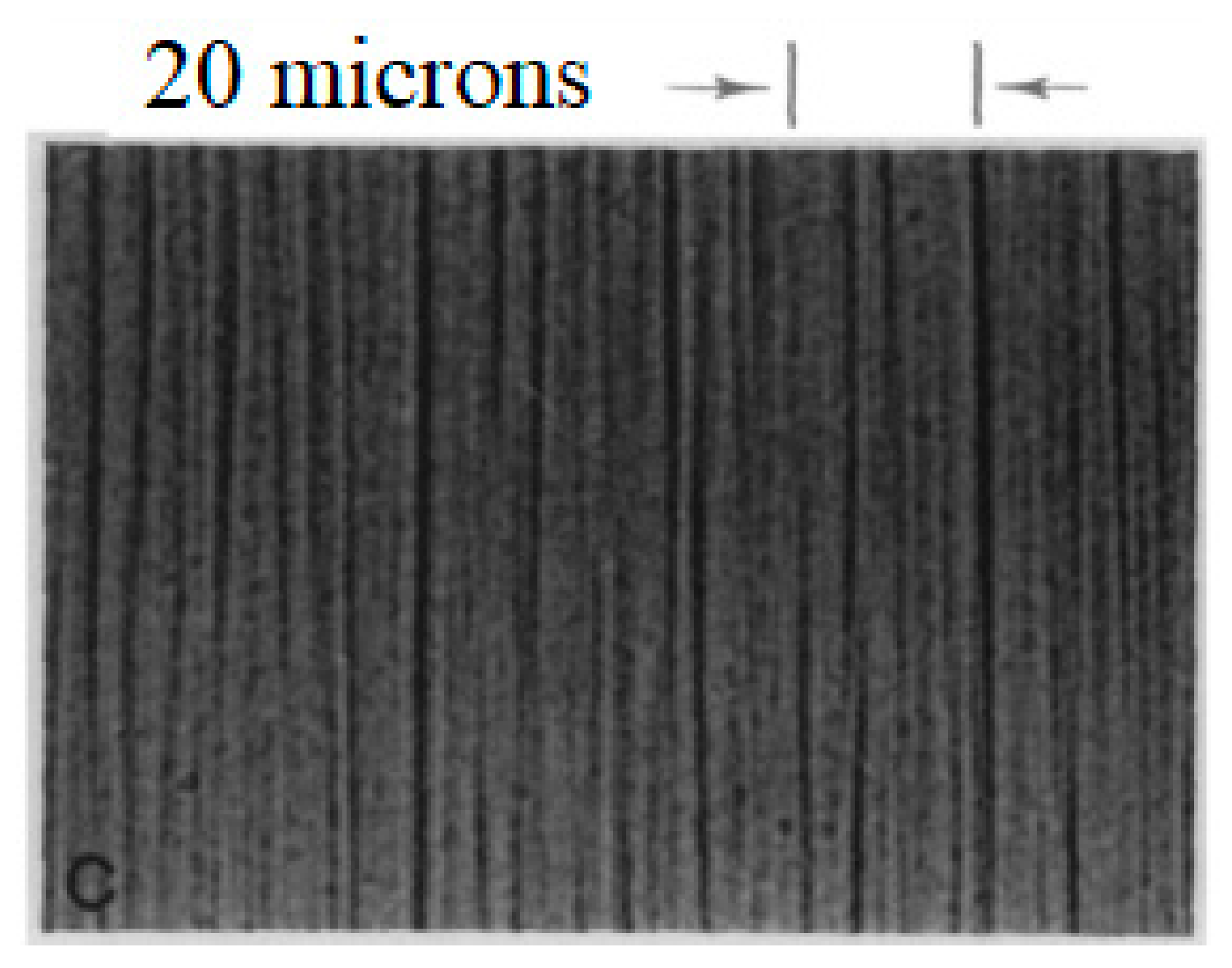

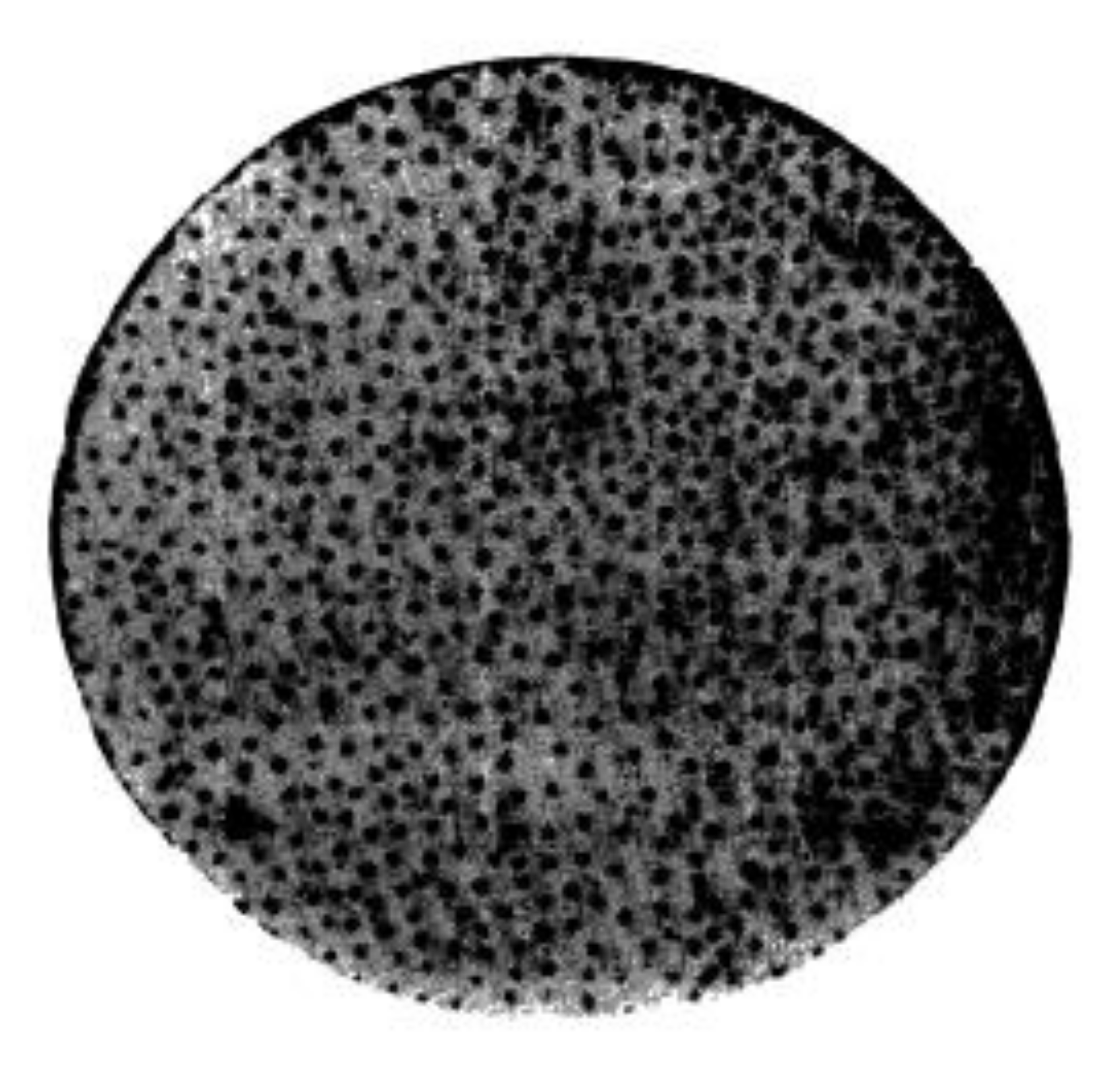
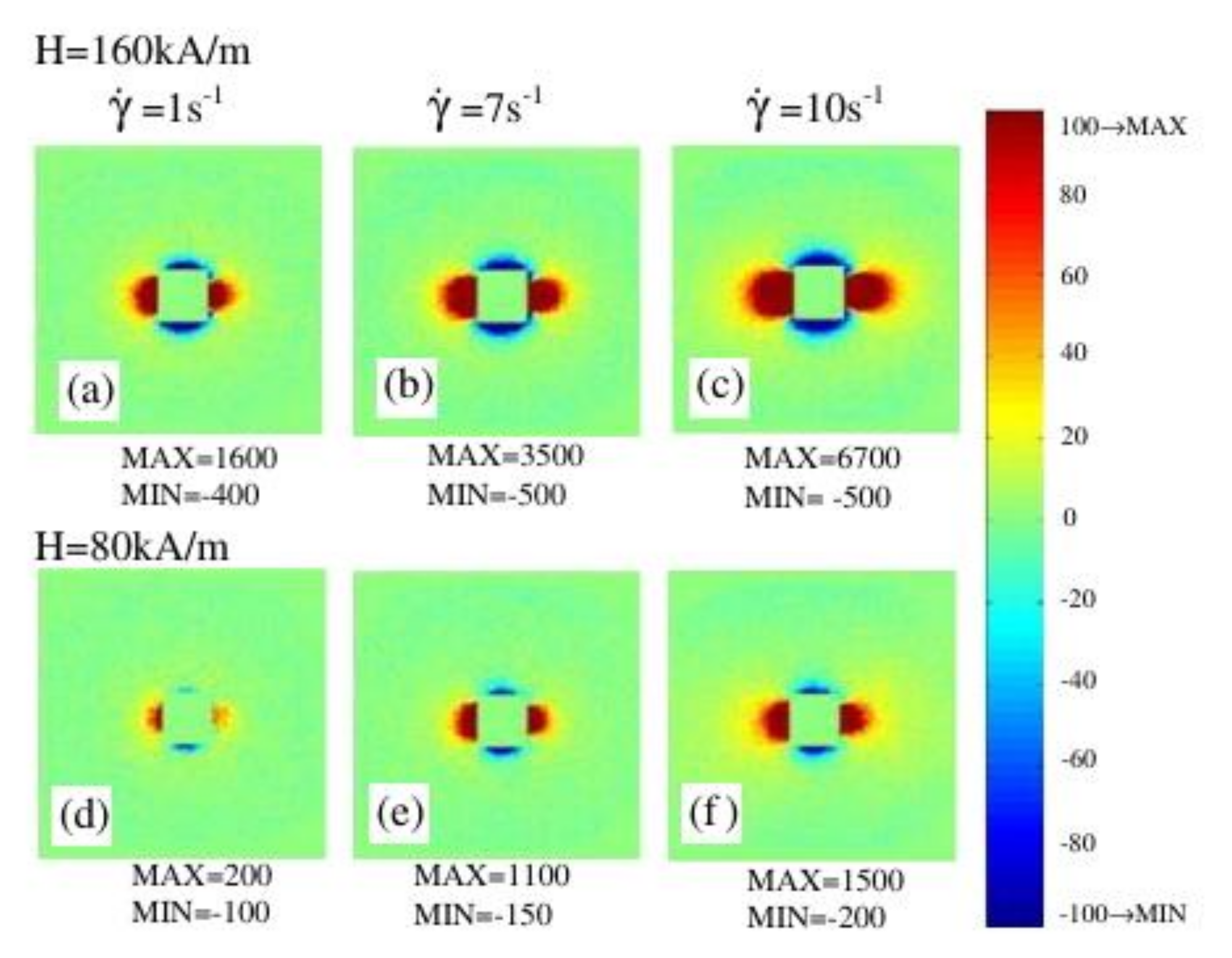
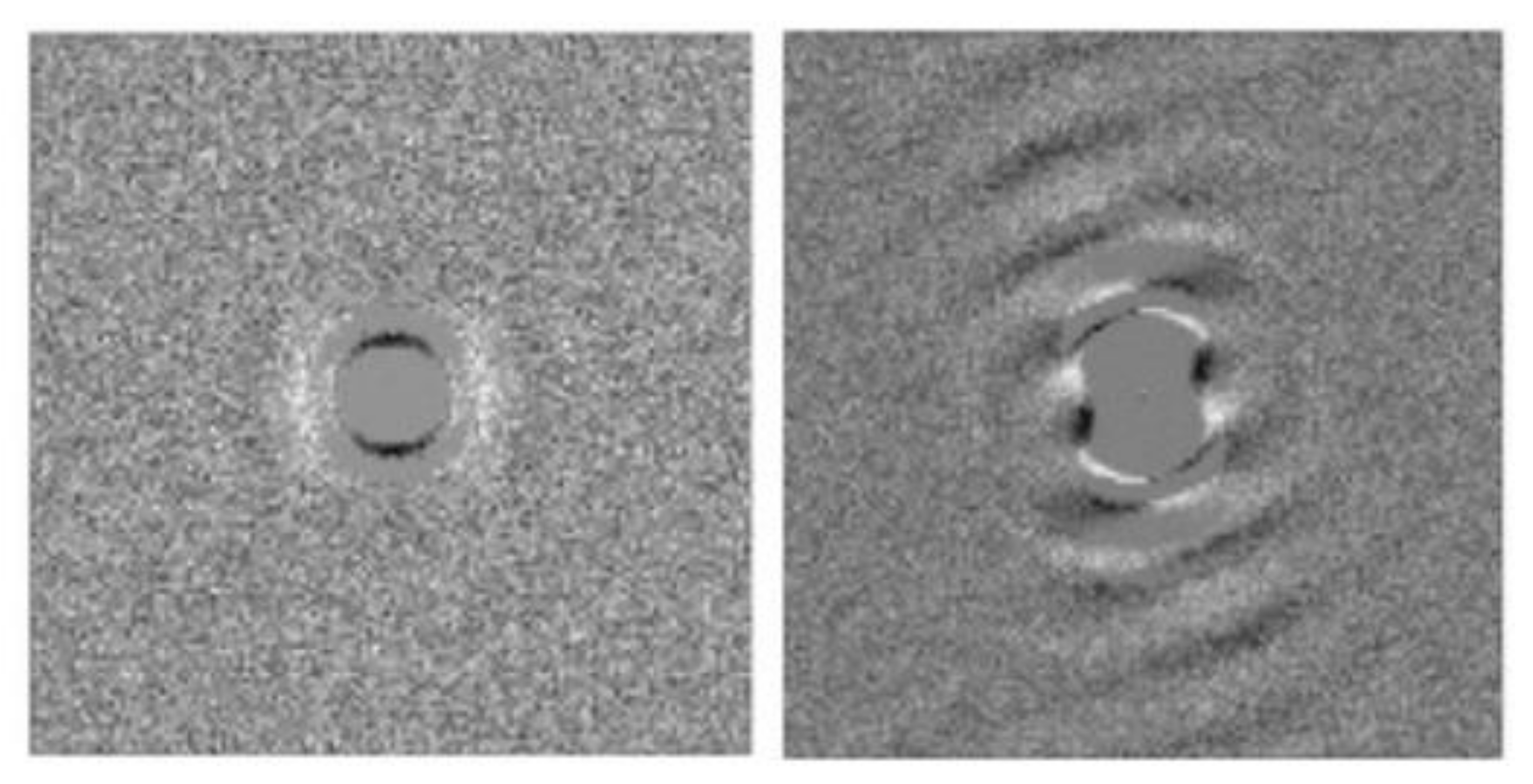
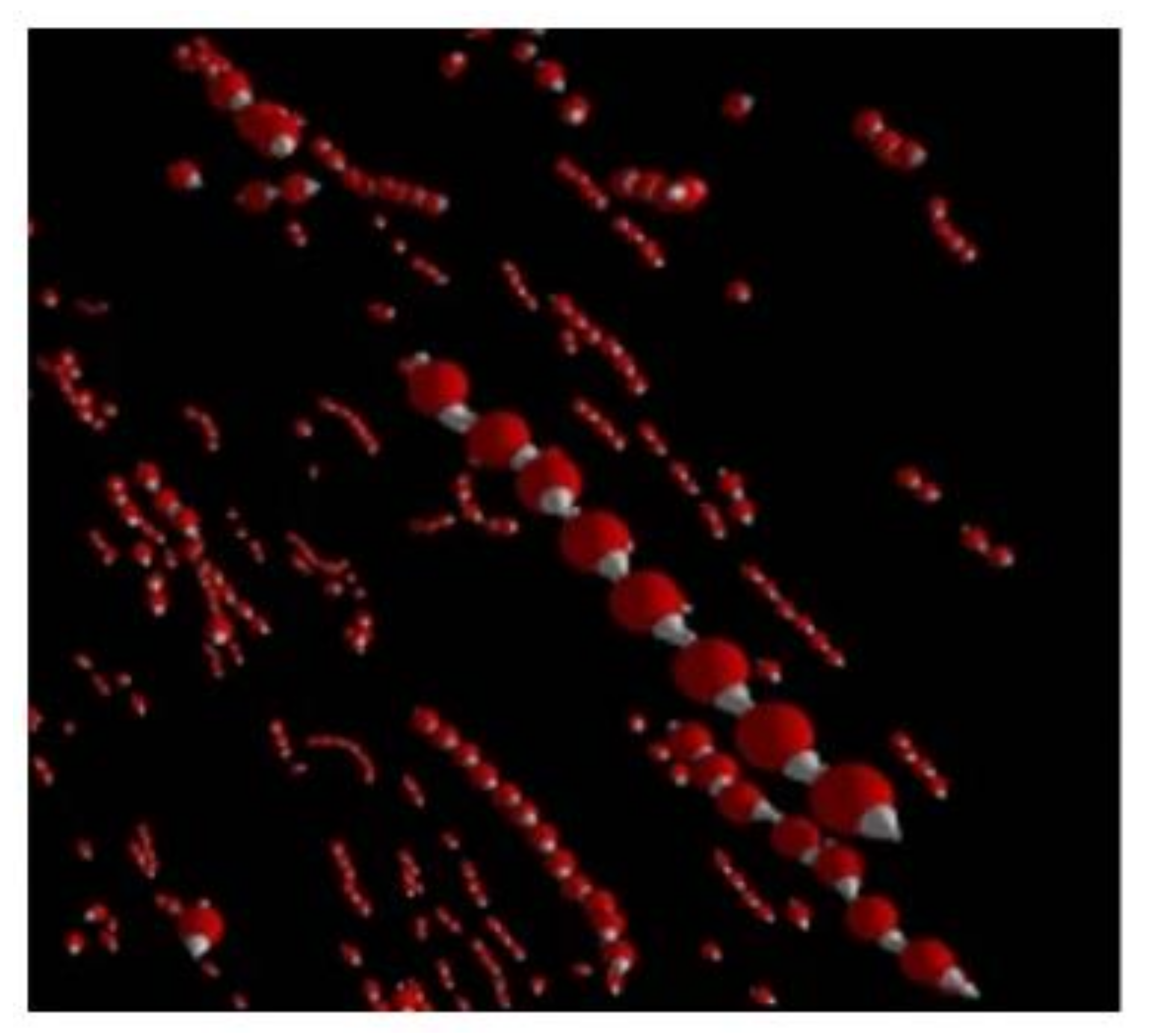

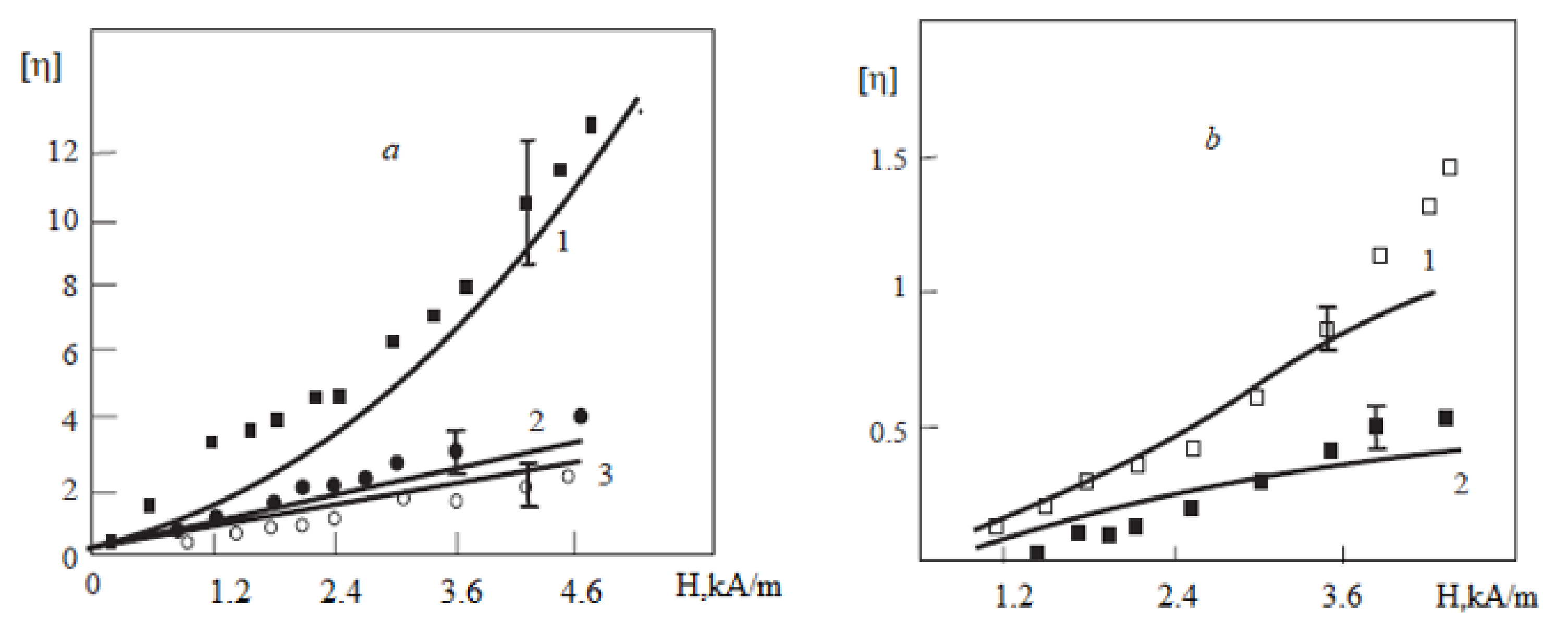
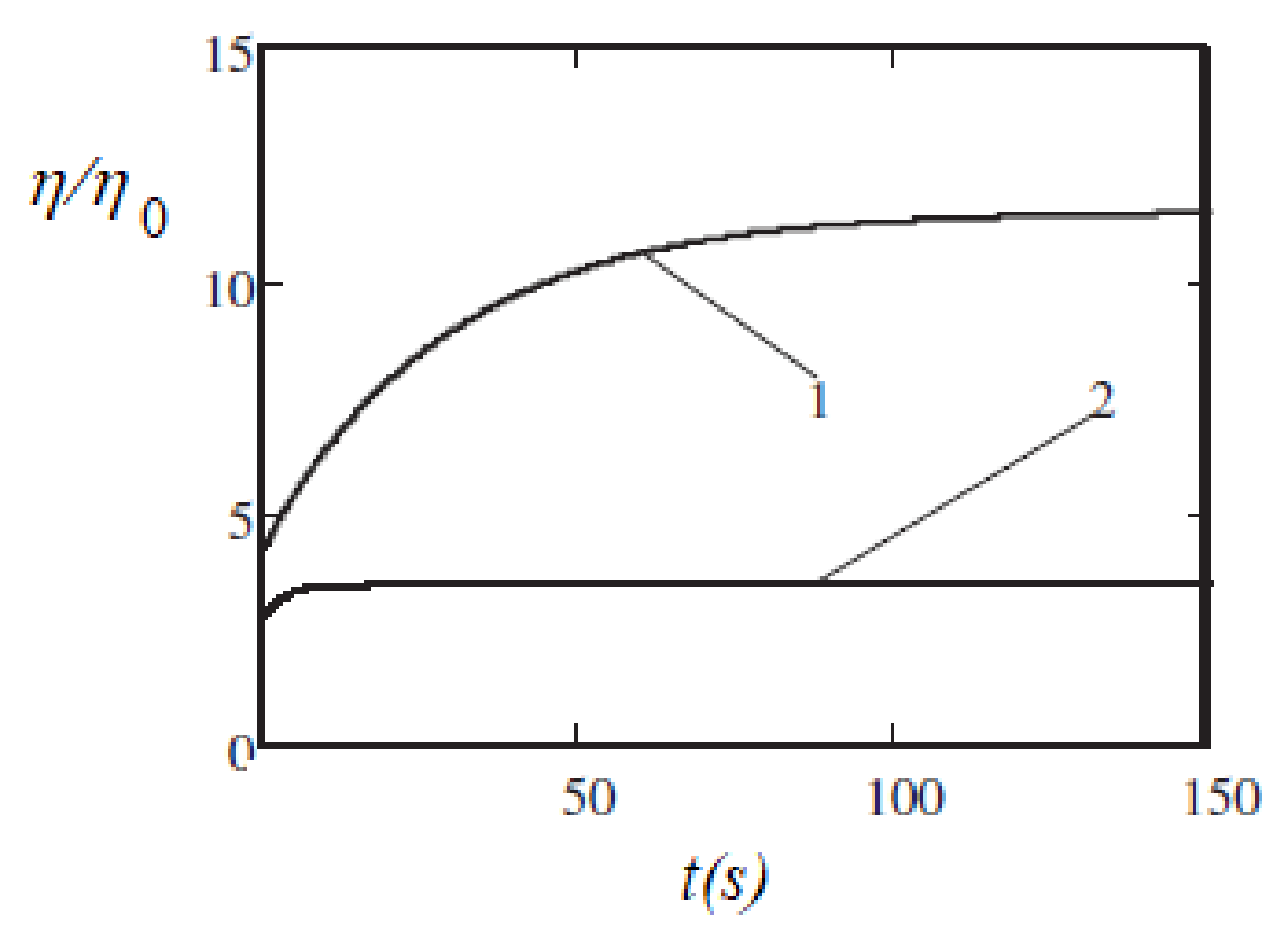
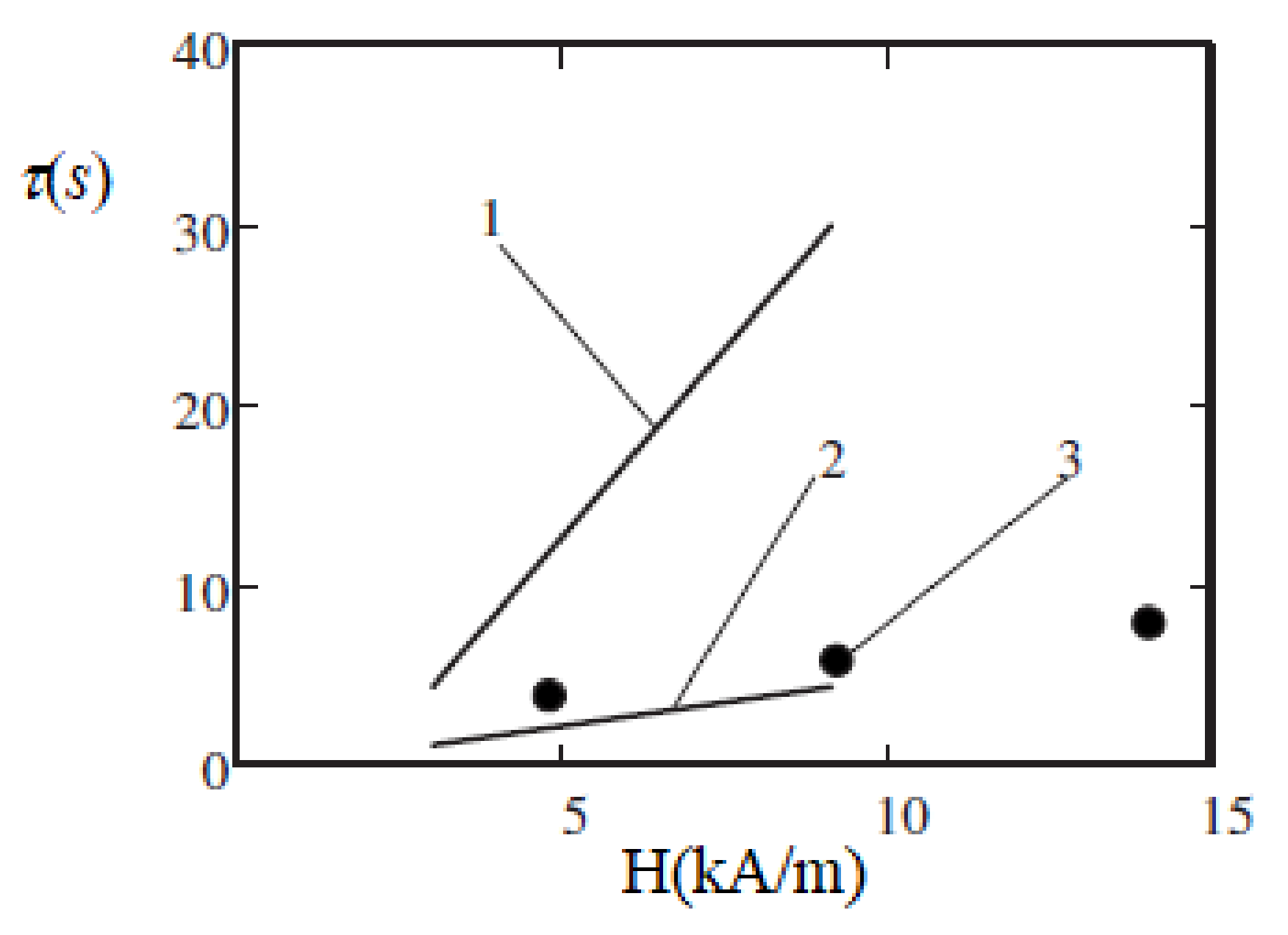
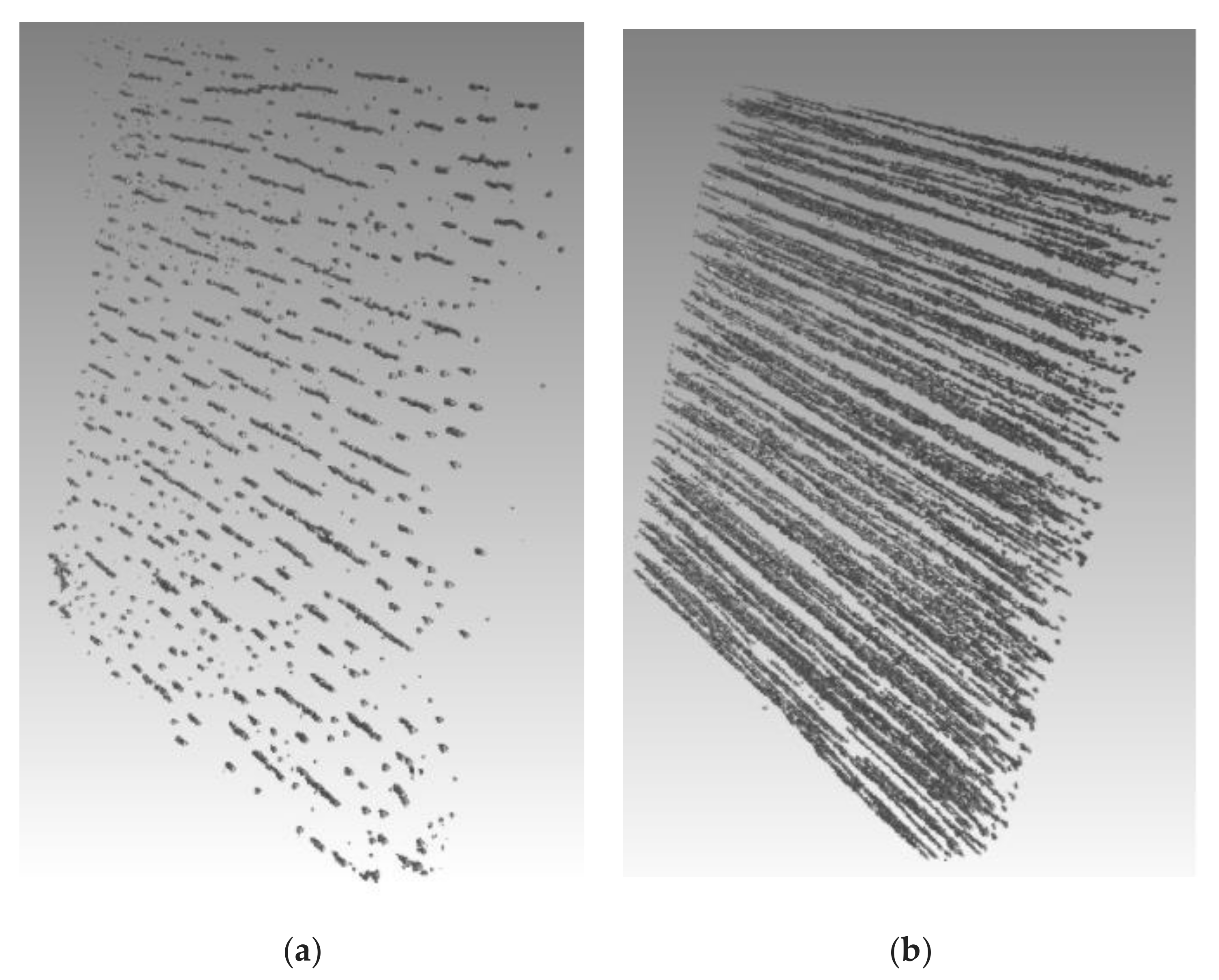
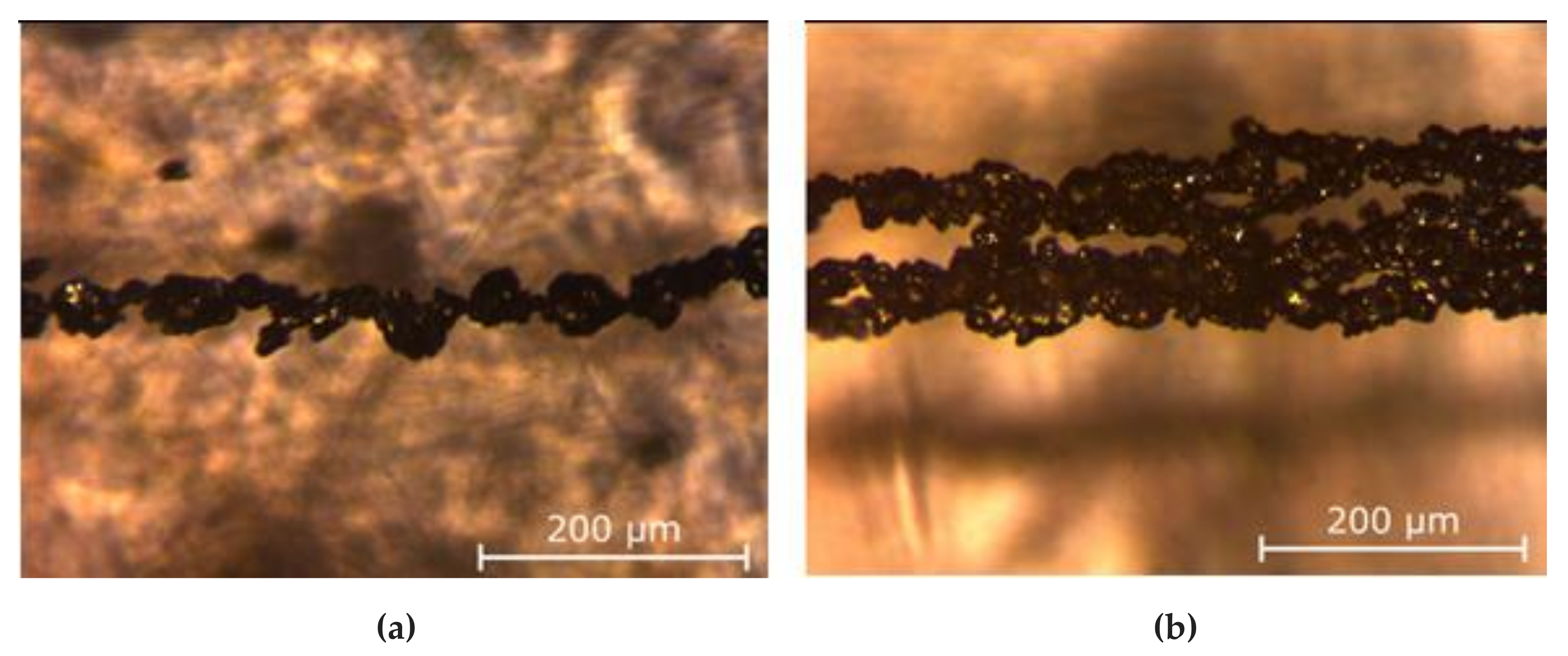
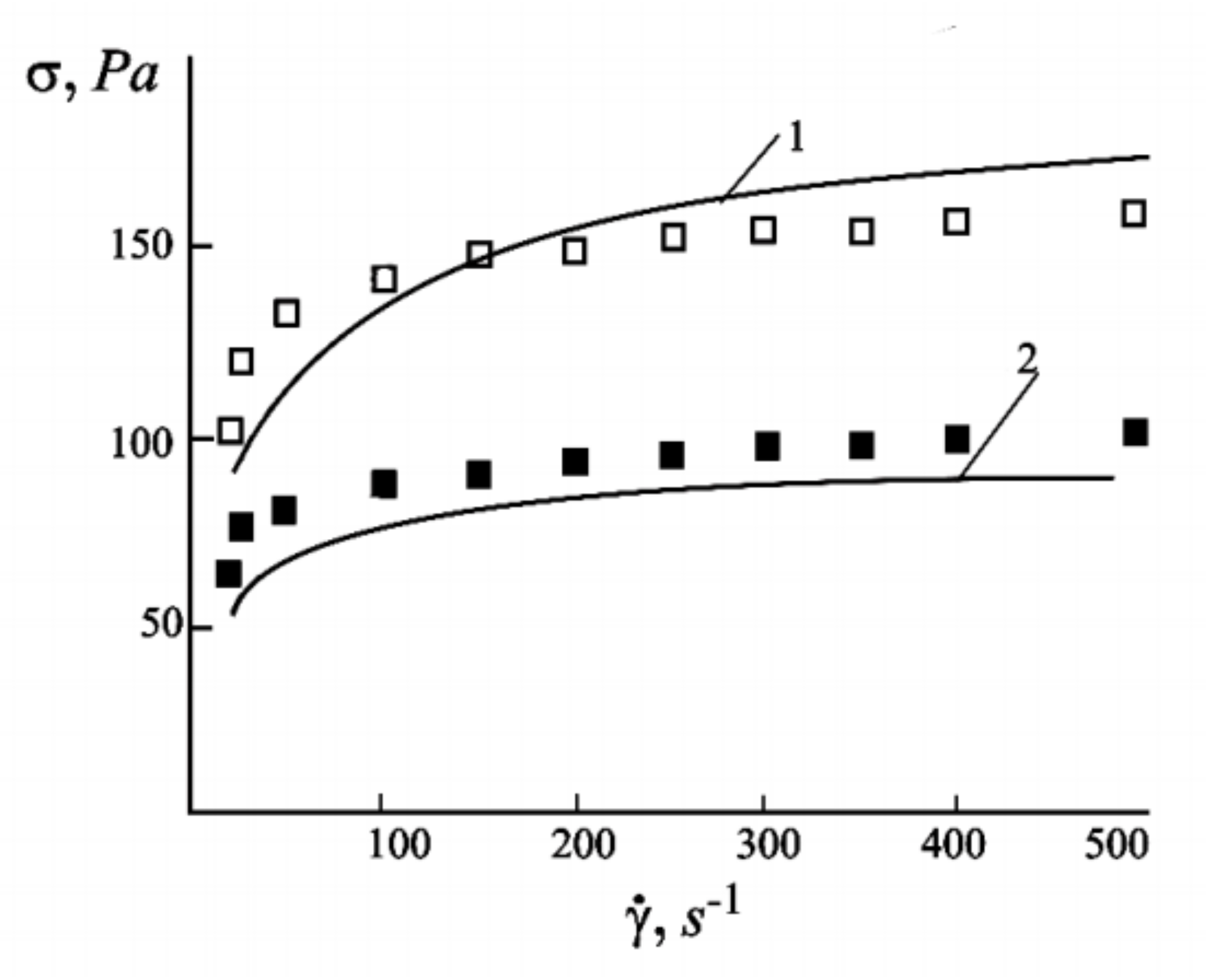
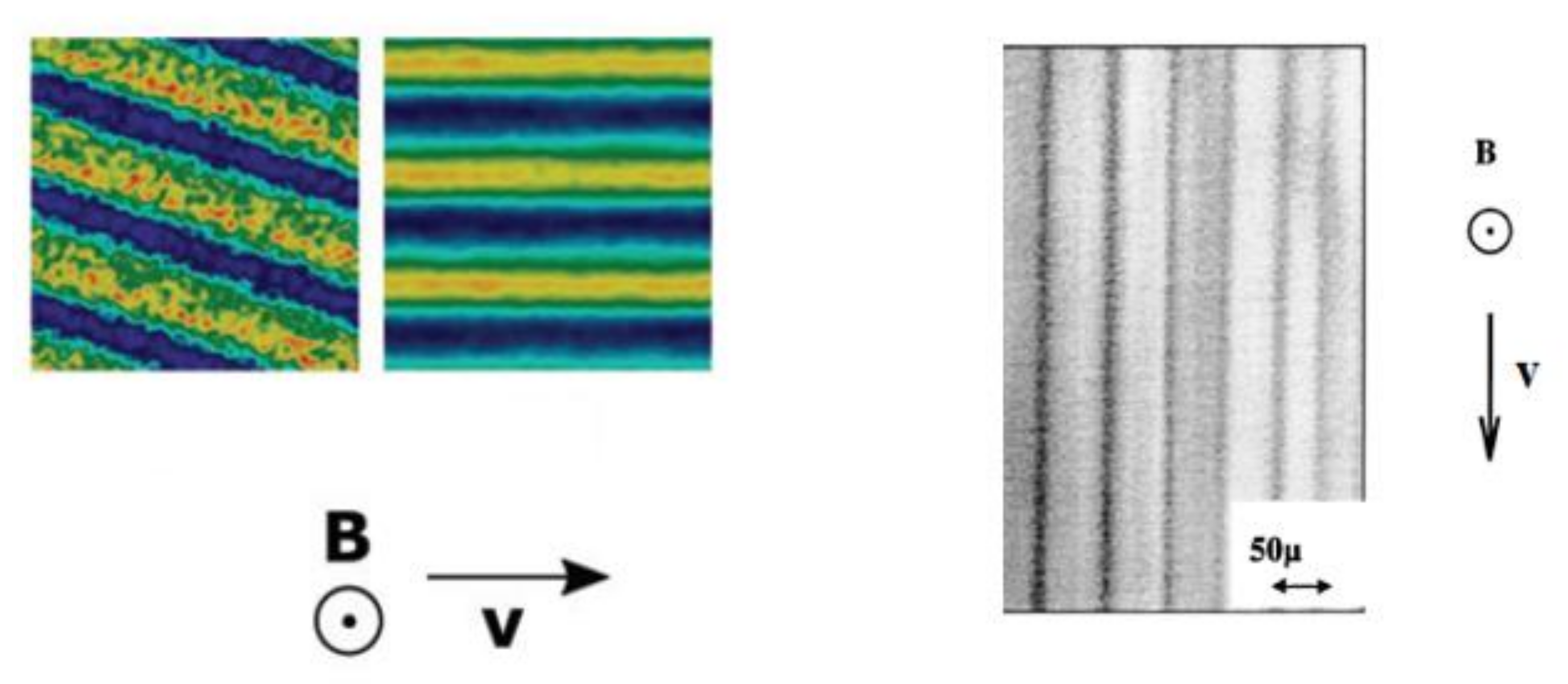
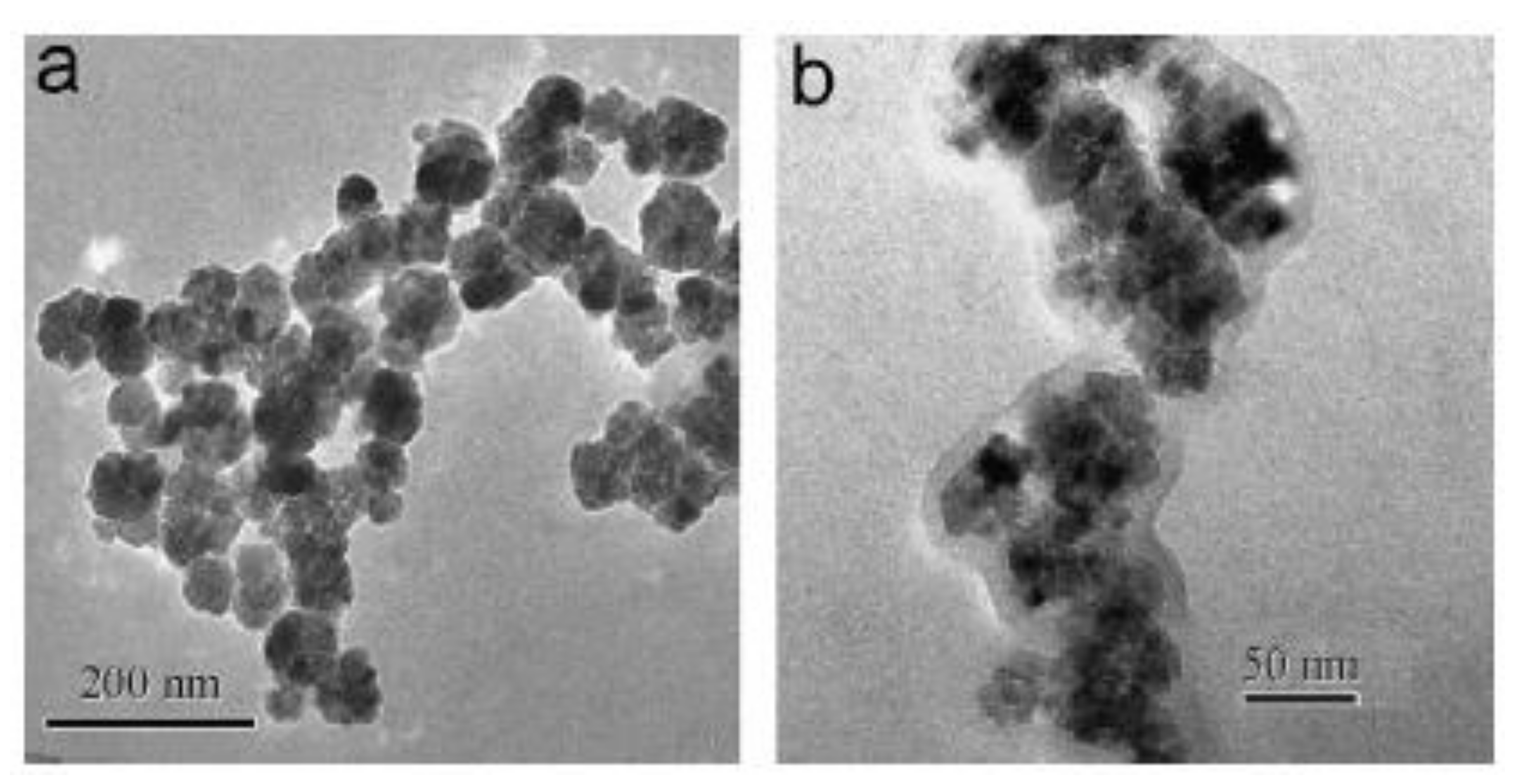
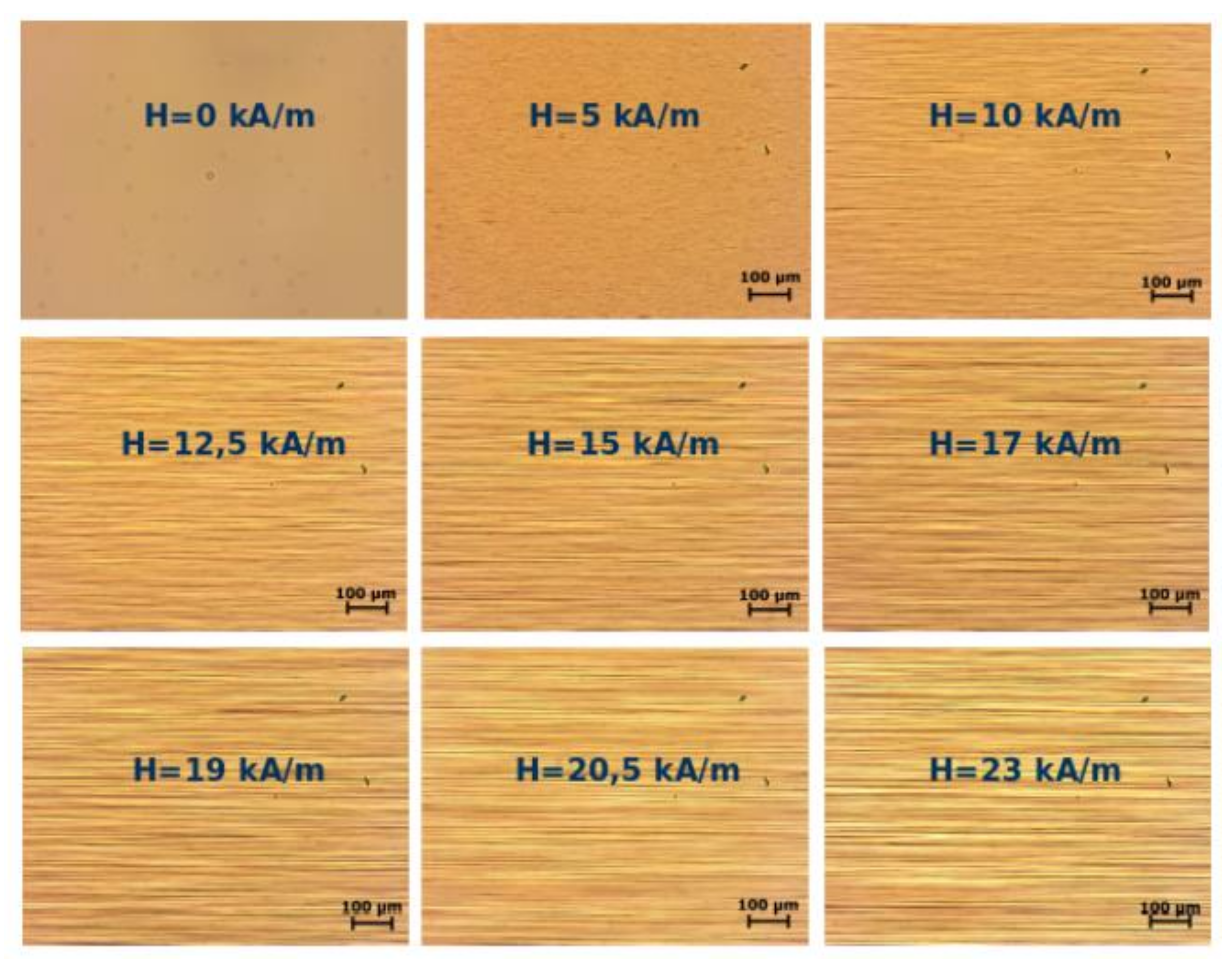
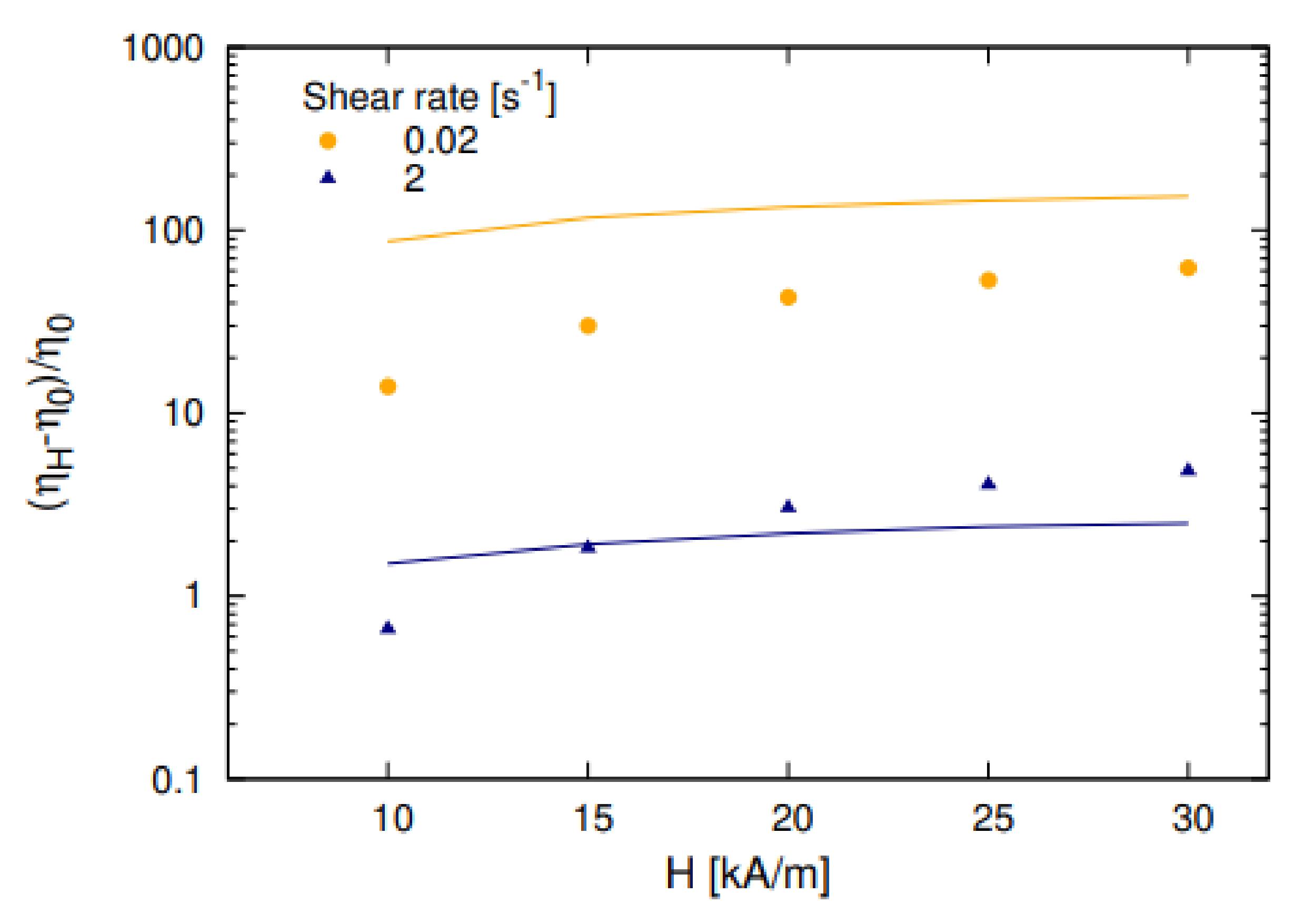
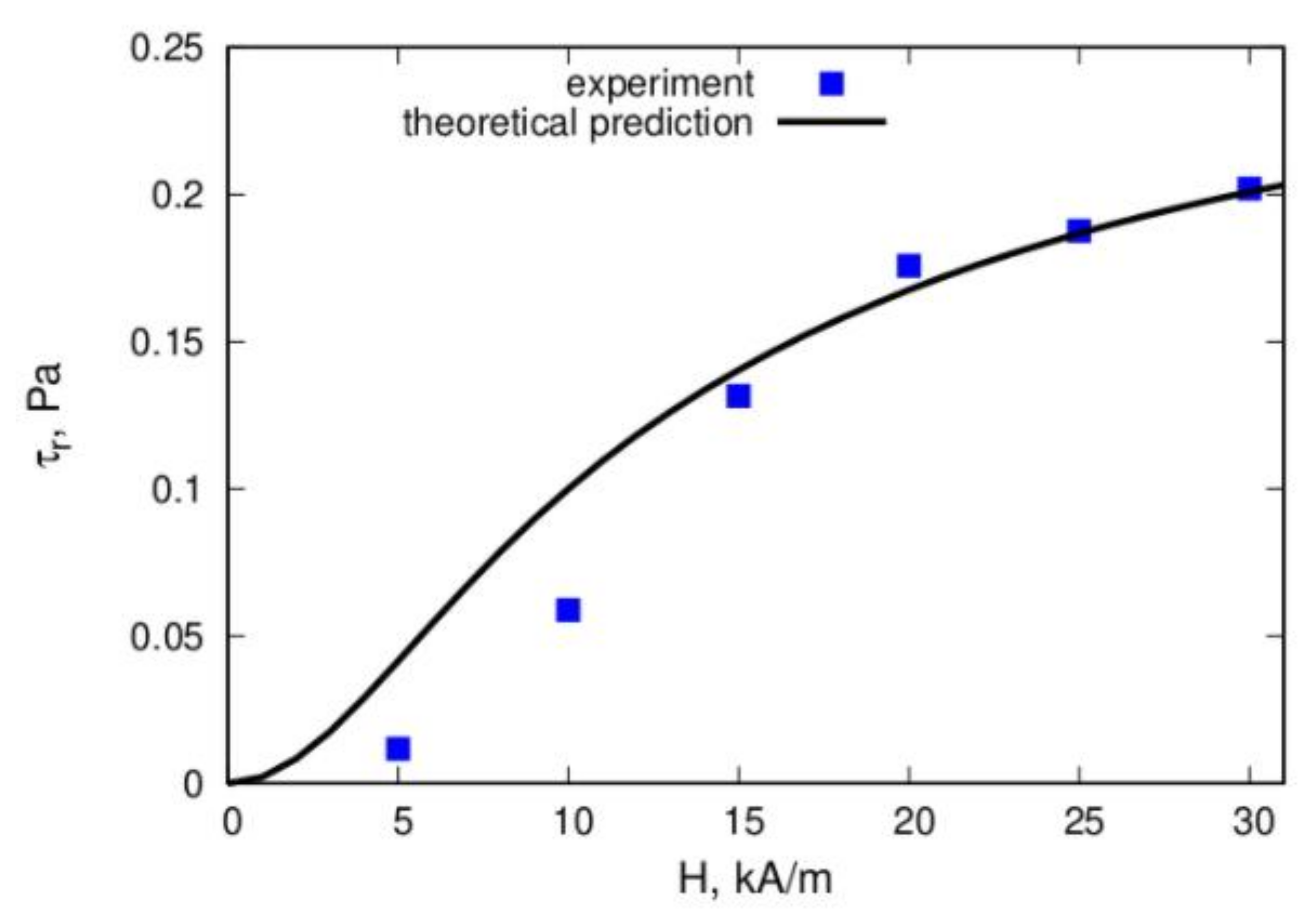
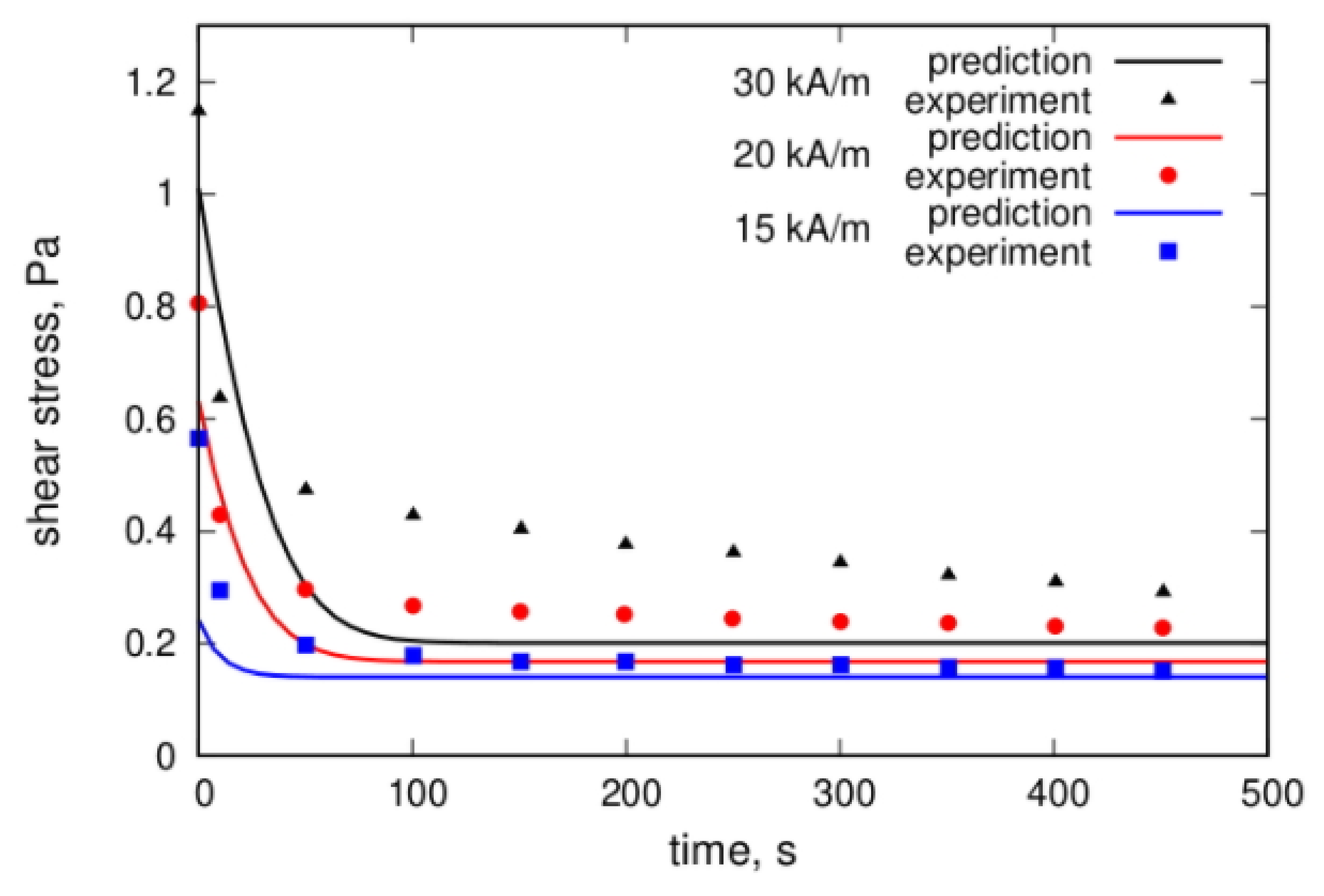
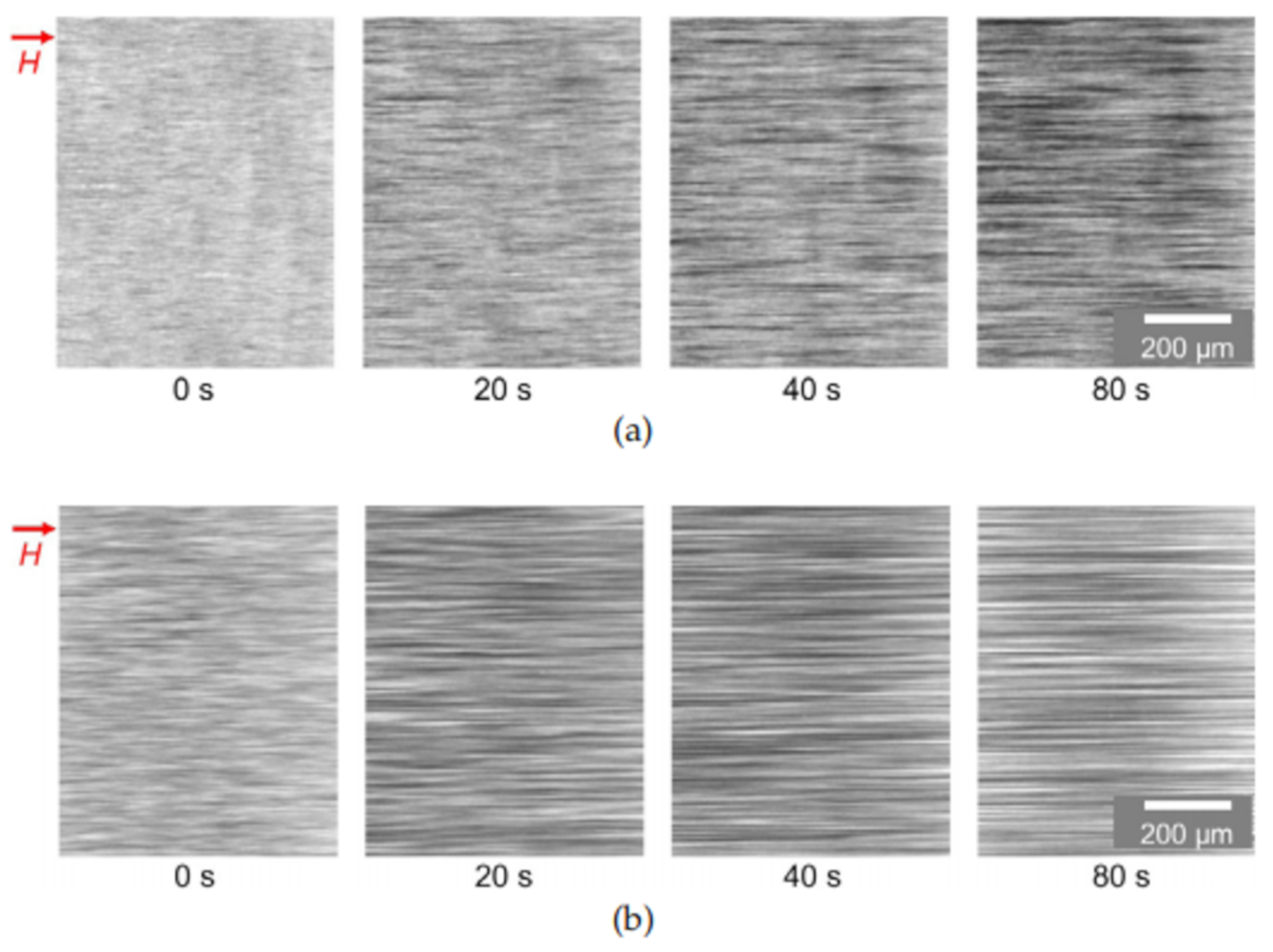
© 2020 by the authors. Licensee MDPI, Basel, Switzerland. This article is an open access article distributed under the terms and conditions of the Creative Commons Attribution (CC BY) license (http://creativecommons.org/licenses/by/4.0/).
Share and Cite
Ivanov, A.O.; Zubarev, A. Chain Formation and Phase Separation in Ferrofluids: The Influence on Viscous Properties. Materials 2020, 13, 3956. https://doi.org/10.3390/ma13183956
Ivanov AO, Zubarev A. Chain Formation and Phase Separation in Ferrofluids: The Influence on Viscous Properties. Materials. 2020; 13(18):3956. https://doi.org/10.3390/ma13183956
Chicago/Turabian StyleIvanov, Alexey O., and Andrey Zubarev. 2020. "Chain Formation and Phase Separation in Ferrofluids: The Influence on Viscous Properties" Materials 13, no. 18: 3956. https://doi.org/10.3390/ma13183956
APA StyleIvanov, A. O., & Zubarev, A. (2020). Chain Formation and Phase Separation in Ferrofluids: The Influence on Viscous Properties. Materials, 13(18), 3956. https://doi.org/10.3390/ma13183956





